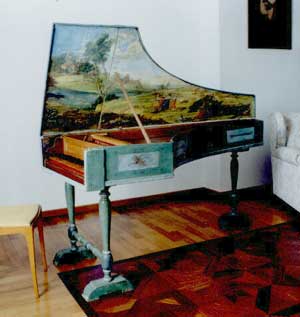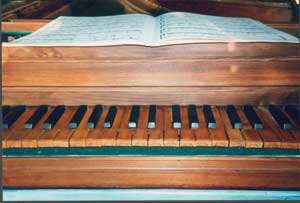
Il Clavicembalo “Nicolaus De Quoco 1699”
La seconda metà del secolo XVII vede un rinnovato fermento nella costruzione dei clavicembali in Italia. Ci sono pervenuti, tuttavia, alcuni strumenti che mantengono invariate le caratteristiche di ambito e di registrazione dei periodi precedenti.
E’ questo il caso del clavicembalo costruito nel 1699 da Nicolò De Quoco; esso possiede una tastiera di 45 note con ottava corta, un ambito in uso fin dai primi decenni del XVI secolo.
L’abete rosso usato per la tavola armonica, in luogo del più usuale cipresso, trasmette al cembalo una piacevole cantabilità. Le tavole armoniche di abete furono utilizzate già per gli strumenti di scuola napoletana nella prima metà del 16° secolo, e richiamano quindi una consuetudine costruttiva assai più antica.
Il clavicembalo è firmato sulla costa anteriore del somiere: NICOLAVS DE QVOCO FECIT ANNO MDCXCIX.
Lo strumento, di costruzione integrale, ha sagoma a forma d’ala con tastiera integrata.
I fianchi e il fondo sono entrambi di pioppo.
Il cembalo appartiene alla tipologia degli strumenti falso levatori il cui corpo, di costruzione integrale, imita uno strumento più leggero inserito nella sua controcassa.
Com’è frequente negli strumenti falso levatori, la cinta del piano armonico è lastronata in cipresso.
La tastiera, di quarantacinque tasti, ha per ambito do1/mi1 – do5 (ottava corta). Il Clavicembalo “Nicolaus De Quoco 1699”
I tasti naturali sono rivestiti con lastrine di bosso. Sui tasti cromatici sono incollati altrettanti blocchetti di noce tinto nero, a loro volta ricoperti con lastrine di ebano. Il clavicembalo ha due registri di 8′. Lo strumento è stato da me restaurato nel 1999 dopo aver subìto altri due interventi di restauro nel decennio precedente, il primo dei quali particolarmente invasivo. Il restauro si è quindi occupato di ripristinare lo stato originario senza procedere a interventi alteranti o non rispettosi della storia del cembalo. Lo strumento monta corde d’ottone ed è impennato con plettri di penna d’oca.
Augusto Bonza
The harpsichord “Nicolaus De Quoco 1699”
The second half of the XVII century witnessed a revival in harpsichord-making in Italy. Nonetheless, a number of instruments have come down to us which have maintained the ranges and tunings employed in previous times.
Hence this particular harpsichord, made in 1699 by Nicolò De Quoco, has a keyboard of 45 notes with short octave, a range which was used until the early decades of the XVI century. Red fir was used for the soundboard instead of the more common cypress and this gives the harpsichord a pleasingly cantabíle character, Fir soundboards were already being used for instruments of the Neapolitan school in the first half of the XVI century and were thus well-established before De Quoco made this particular model, which carries the following on the front side of the “somiere”: NICOLAVS DE QVOCO FECIT ANNO MDCXCIX.
The instrument is built as one piece and is in the shape of a wing.
The keyboard is not removable.
The sides and bottom ore made of poplar wood.
This harpsichord belongs to the class of instruments known as falso levatori. The body is built as one piece but imitates the lighter sort of instruments which were inserted into an external casing. As is often the case with falso levatori instruments, the edge of the soundboard is beaded with cypress wood. Harpsichord “Nicolaus De Quoco 1699”
The keyboard has fourty-five keys and the range is CI/P – C5 (short octave).
The natural keys ore veneered with boxwood, while the chromatic keys each have a small block of walnut glued on and painted black, then covered with strips of ebony. The harpsichord has two registers of 8′.
I restored this instrument in 1999. It had been restored twice in the previous ten years, on the first of which occasions it had been subjected to considerable tampering in an attempt at supposed1y “improving” it. It thus fell to me to restore the instrument to its original state, doing nothing to alter the sound or structure of the harpsichord as conceived by De Quoco. The instrument uses brass strings and goose quill plectra.
For the present recording, this harpsichord was tuned in mesotonic temperament, at114 comma.
Augusto Bonza
